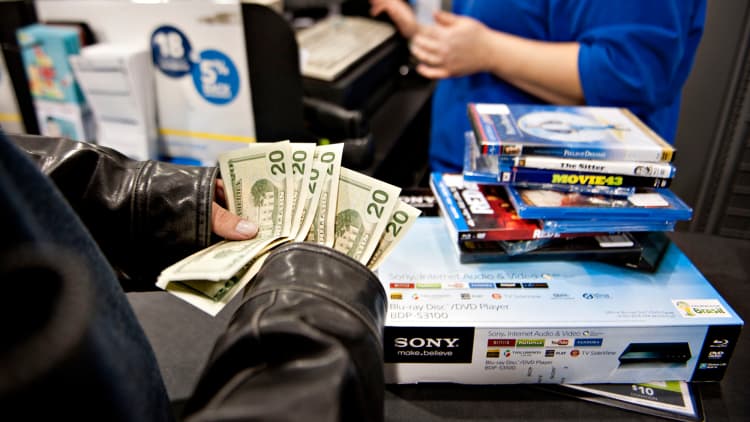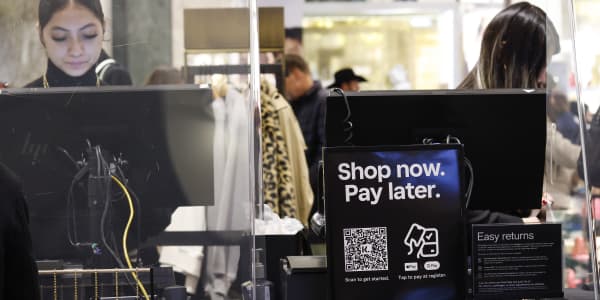Reading the tea leaves on today's consumers can be a challenge when they're saying such different things.
On one hand, the nation's unemployment rate is ticking lower, gas prices are on the decline and the stock market is hitting record highs. On the other hand, much of the country is struggling to shake off the aftermath of the recession, as about half of working-age adults are still either filling part-time roles or are unemployed, according to Customer Growth Partners. And many of those with jobs have seen their wages stagnate.
At first glance the data appears rather schizophrenic: Multiple sales forecasts are calling for 4 percent or greater growth this holiday, while much of the population is still struggling to get by. A closer look at the numbers, however, shows the root of this disconnect lies in the fact that it's one set of consumers who are reaping most of the benefits: Those on the high end.
"People, especially at the lower-income levels, were extremely hard hit with jobs," said Vishwa Chandra, a principal in the retail practice of A.T. Kearney. "They're cautious to sort of really start to spend."
Read MoreIs that all ya' got? Black Friday raising skepticism
Findings by both the National Retail Federation and PwC back up this sentiment. According to the NRF, those who earn less than $50,000 a year plan to spend $516.95 for the holidays, only $5.15 more than in 2013. Those who make over $50,000, on the other hand, will spend $1,055.39, an increase of $46.75.
In PwC's holiday forecast, this disconnect caused the firm to split the consumer base into two distinct categories: Selectionists, who make more than $50,000 a year, and survivalists, who make less than $50,000 a year.
Not only will the survivalists spend less this year — on average $377 per household, compared with $978 per household for selectionists — but they're also planning to spend significantly less as a group compared with the prior year. The number of people who fall into the survivalist category is also two percentage points higher than it was last year, at 67 percent.
Read MoreHolidays to separate retail winners from losers
"The spending divide among shoppers is widening," said Steve Barr, PwC's U.S. retail and consumer practice leader.

According to Customer Growth Partners, one of the biggest factors behind the divide stems from the employment picture. Although the unemployment rate has ticked lower over the past year, labor force participation rates are still hovering near 60 percent, which is the lowest since the 1970s. The impact of this, as well as "flatlining" real income growth and rising food prices, are expected to counteract the benefits of falling gasoline prices for lower-income consumers, according to CGP.
"A distinct two-tier consumer economy has emerged in the past two years, as households with full-time jobs enjoy their healthiest balance sheet in decades," the report said. "But, households with only part-time jobs or unemployed … will spend primarily on nondiscretionary goods, and then only very cautiously."
Will this disconnect determine retail’s winners and losers?
A.T. Kearney's Chandra said there are signs that the lower-income consumer is starting to feel relief, particularly at the pump. That should give a boost to the dollar stores and deep discounters of the world, including Wal-Mart, he said. But that still doesn't mean these consumers will spend freely, and competition will remain fierce throughout the holiday season.
Retailers, particularly in the discount and midtier sectors, are already offering significant savings to shoppers to effectively compete. Companies including Macy's and Target are also opening their doors even earlier Thanksgiving Day to try to capture deal-seeking shoppers.
Read MoreLingerie to jewelry: What to buy her this year
For its part, Wal-Mart is hoping the fact that it lapped a 6 percent reduction in food stamp (SNAP) benefits at the start of November will help boost its top line. Separately, the retailer said that three times as many Americans are expecting paychecks on Cyber Monday this year, which could boost its sales in the online segment that day.
Things were certainly starting to look better for both Wal-Mart and several other low-cost names in their most recent earnings reports.
"Improving top-lines at Dollar Tree, Wal-Mart, Target [and] Ross could indicate a trough for low-income consumer spending, as fuel prices have fallen and SNAP cuts are lapped," Goldman Sachs analyst Stephen Grambling wrote in a note to investors Monday.
Chandra predicts off-price retailers such as TJX and Ross Stores, as well as Nordstrom's Rack, Saks' Off Fifth and Neiman Marcus' Last Call concepts, will continue to benefit from label-conscious middle-income shoppers who aren't migrating back to higher-price stores.
On Tuesday, J.P. Morgan analyst Matthew Boss upgraded TJX to "overweight" from "neutral," in part due to the growth prospects for the off-price sector. In a note to investors, Boss referenced a meeting with TJX CEO Carol Meyrowitz, in which she referenced the company's first positive traffic numbers in a year last quarter, and a broadened consumer base shopping at its stores. That includes those with a household income between $50,000 and $1 million annually.
"Their eyes have been opened to, 'There are discount channels where I can spend and get value,' " Chandra said. "They're not migrating back."
Read MoreBlack Friday isn't dead! Here's why
Although Ross Stores also posted a strong quarter, with same-store sales rising 4 percent, it nonetheless sounded a cautious note for the fourth quarter, saying the promotional environment could cause it to lose some share.
Still, most analysts speculate it will be the full-line companies that focus on middle-income consumers — particularly in the apparel sector — that will get squeezed out this holiday. Compounding the problem for these retailers is the fact that aside from athleisure, there is no major apparel trend driving spending.
On the flipside, Piper Jaffray analysts Erinn Murphy and Neely Tamminga named high-end brands Michael Kors and Nordstrom as two of their top names heading into the holiday. And with consumers expected to spend a significant share of their wallets on consumer electronics and jewelry this holiday, analysts are also bullish on high-end jeweler Tiffany, as well as Apple and Best Buy.
The top end of luxury, in particular, is expected to do well.
"They are a little more insulated from ... these swings," Chandra said.




